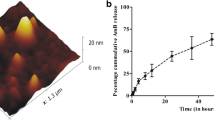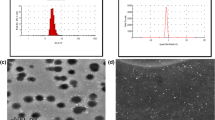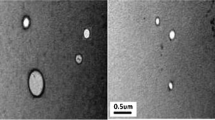ABSTRACT
Purpose
To fabricate, characterize and evaluate 3-O-sn-Phosphatidyl-L-serine (PhoS) anchored PLGA nanoparticles for macrophage targeted therapeutic intervention of VL.
Materials and Methods
PLGA-AmpB NPs were prepared by well-established nanoprecipitation method and decorated with Phos by thin film hydration method. Physico-chemical characterization of the formulation was done by Zetasizer nano ZS and atomic force microscopy.
Results
The optimized formulation (particle size, 157.3 ± 4.64 nm; zeta potential, − 42.51 ± 2.11 mV; encapsulation efficiency, ∼98%) showed initial rapid release up to 8 h followed by sustained release until 72 h. PhoS generated ‘eat-me’ signal driven augmented macrophage uptake, significant increase in in-vitro (with ∼82% parasite inhibition) and in-vivo antileishmanial activity with preferential accumulation in macrophage rich organs liver and spleen were found. Excellent hemo-compatibility justified safety profile of developed formulation in comparison to commercial formulations.
Conclusion
The developed PhoS-PLGA-AmpB NPs have improved efficacy, and necessary stability which promisingly put itself as a better alternative to available commercial formulations for optimized treatment of VL.







Similar content being viewed by others
Abbreviations
- AmpB:
-
Amphotericin B
- AmpT:
-
Amphotreat
- LamN:
-
Lambin
- PhoS:
-
3-O-sn-Phosphatidyl-L-serine
- PLGA:
-
Poly (lactic-co-glycolic acid)
- VL:
-
Visceral leishmaniasis
References
Asthana S, Jaiswal AK, Gupta PK, Dube A, Chourasia MK. Th-1 biased immunomodulation and synergistic antileishmanial activity of stable cationic lipid–polymer hybrid nanoparticle: biodistribution and toxicity assessment of encapsulated amphotericin B. Eur J Pharm Biopharm. 2015;89:62–73.
Sundar S, More DK, Singh MK, Singh VP, Sharma S, Makharia A, et al. Failure of pentavalent antimony in visceral leishmaniasis in India: report from the center of the Indian epidemic. Clin Infect Dis. 2000;31:1104–7.
Tiuman TS, Santos AO, Ueda-Nakamura T, Filho BP, Nakamura CV. Recent advances in leishmaniasis treatment. Int J Infect Dis. 2011;15:e525–32.
Boelaert M, Criel B, Leeuwenburg J, Van Damme W, Le Ray D, Van der Stuyft P. Visceral leishmaniasis control: a public health perspective. Trans R Soc Trop Med Hyg. 2000;94:465–71.
Krieger M. Scavenger receptor class B type I is a multiligand HDL receptor that influences diverse physiologic systems. J Clin Invest. 2001;108:793–7.
Ravichandranand KS, Lorenz U. Engulfment of apoptotic cells: signals for a good meal. Nat Rev Immunol. 2007;7:964–74.
Platt N, da Silva RP, Gordon S. Class A scavenger receptors and the phagocytosis of apoptotic cells. Immunol Lett. 1999;65:15–9.
Schlegeland RA, Williamson P. Phosphatidylserine, a death knell. Cell Death Differ. 2001;8:551–63.
Kansal S, Tandon R, Dwivedi P, Misra P, Verma PR, Dube A, et al. Development of nanocapsules bearing doxorubicin for macrophage targeting through the phosphatidylserine ligand: a system for intervention in visceral leishmaniasis. J Antimicrob Chemother. 2012;67:2650–60.
Chen X, Doffek K, Sugg SL, Shilyansky J. Phosphatidylserine regulates the maturation of human dendritic cells. J Immunol (Baltimore, Md : 1950). 2004;173:2985–94.
Khatik R, Dwivedi P, Khare P, Kansal S, Dube A, Mishra PR, et al. Development of targeted 1,2-diacyl-sn-glycero-3-phospho-l-serine-coated gelatin nanoparticles loaded with amphotericin B for improved in vitro and in vivo effect in leishmaniasis. Expert Opin Drug Deliv. 2014;11:633–46.
Geelen T, Yeo SY, Paulis LE, Starmans LW, Nicolay K, Strijkers GJ. Internalization of paramagnetic phosphatidylserine-containing liposomes by macrophages. J Nanobiotechnol. 2012;10:37.
Tempone AG, Perez D, Rath S, Vilarinho AL, Mortara RA, de Andrade HF Jr. Targeting Leishmania (L.) chagasi amastigotes through macrophage scavenger receptors: the use of drugs entrapped in liposomes containing phosphatidylserine. J Antimicrob Chemother. 2004;54:60–8.
Danhier F, Ansorena E, Silva JM, Coco R, Le Breton A, Préat V. PLGA-based nanoparticles: An overview of biomedical applications. J Control Release. 2012;161:505–22.
Bala I, Hariharan S, Kumar MN. PLGA nanoparticles in drug delivery: the state of the art. Crit Rev Ther Drug Carrier Syst. 2004;21:387–422.
Singh PK, Sah P, Meher JG, Joshi S, Pawar VK, Raval K, et al. Macrophage-targeted chitosan anchored PLGA nanoparticles bearing doxorubicin and amphotericin B against visceral leishmaniasis. RSC Adv. 2016;6:71705–18.
Singh P, Gupta A, Jaiswal A, Dube A, Mishra S, Chaurasia MK. Design and development of Amphotericin B bearing polycaprolactone microparticles for macrophage targeting. J Biomed Nanotechnol. 2011;7:50–1.
Guzzarlamudi S, Singh PK, Pawar VK, Singh Y, Sharma K, Paliwal SK, et al. Synergistic Chemotherapeutic Activity of Curcumin Bearing Methoxypolyethylene Glycol-g-Linoleic Acid Based Micelles on Breast Cancer Cells. J Nanosci Nanotechnol. 2016;16:4180–90.
Chaurasia M, Singh PK, Jaiswal AK, Kumar A, Pawar VK, Dube A, et al. Bioinspired Calcium Phosphate Nanoparticles Featuring as Efficient Carrier and Prompter for Macrophage Intervention in Experimental Leishmaniasis. Pharm Res. 2016;33:2617–29.
Pawar VK, Panchal SB, Singh Y, Meher JG, Sharma K, Singh P, et al. Immunotherapeutic vitamin E nanoemulsion synergies the antiproliferative activity of paclitaxel in breast cancer cells via modulating Th1 and Th2 immune response. J Control Release. 2014;196:295–306.
Gupta PK, Jaiswal AK, Asthana S, Verma A, Kumar V, Shukla P, et al. Self Assembled Ionically Sodium Alginate Cross-Linked Amphotericin B Encapsulated Glycol Chitosan Stearate Nanoparticles: Applicability in Better Chemotherapy and Non-Toxic Delivery in Visceral Leishmaniasis. Pharm Res. 2015;32:1727–40.
Gupta G, Oghumu S, Satoskar AR. Mechanisms of Immune Evasion in Leishmaniasis. Adv Appl Microbiol. 2013;82:155–84.
Asthana S, Jaiswal AK, Gupta PK, Pawar VK, Dube A, Chourasia MK. Immunoadjuvant chemotherapy of visceral leishmaniasis in hamsters using Amphotericin B-encapsulated nanoemulsion template-based chitosan nanocapsules. Antimicrob Agents Chemother. 2013;57:1714–22.
Sundar S, Mehta H, Suresh AV, Singh SP, Rai M, Murray HW. Amphotericin B treatment for Indian visceral leishmaniasis: conventional versus lipid formulations. Clin Infect Dis: Off Publ Infect Dis Soc Am. 2004;38:377–83.
Ravichandran KS. Find-me and eat-me signals in apoptotic cell clearance: progress and conundrums. J Exp Med. 2010;207:1807–17.
Makadiaand HK, Siegel SJ. Poly Lactic-co-Glycolic Acid (PLGA) as Biodegradable Controlled Drug Delivery Carrier. Polymers. 2011;3:1377–97.
Omar Zaki SS, Ibrahim MN, Katas H. Particle size affects concentration-dependent cytotoxicity of chitosan nanoparticles towards mouse hematopoietic stem cells. J Nanotechnol. 2015;2015:1–5.
He C, Hu Y, Yin L, Tang C, Yin C. Effects of particle size and surface charge on cellular uptake and biodistribution of polymeric nanoparticles. Biomaterials. 2010;31:3657–66.
Knopik-Skrockaand A, Bielawski J. Differences in amphotericin-B-induced hemolysis between human erythrocytes from male and female donors. Biol Lett. 2005;42:49–60.
Kotler-Brajtburg J, Medoff G, Kobayashi G, Boggs S, Schlessinger D, Pandey R, et al. Classification of polyene antibiotics according to chemical structure and biological effects. Antimicrob Agents Chemother. 1979;15:716–22.
Wu Y, Tibrewal N, Birge RB. Phosphatidylserine recognition by phagocytes: a view to a kill. Trends Cell Biol. 2006;16:189–97.
Kimani SG, Geng K, Kasikara C, Kumar S, Sriram G, Wu Y, et al. Contribution of Defective PS Recognition and Efferocytosis to Chronic Inflammation and Autoimmunity. Front Immunol. 2014;5:566.
Galvan MD, Foreman DB, Zeng E, Tan JC, Bohlson SS. Complement component C1q regulates macrophage expression of Mer tyrosine kinase to promote clearance of apoptotic cells. J Immunol (Baltimore, Md : 1950). 2012;188:3716–23.
Osterand CN, Nacy CA. Macrophage activation to kill Leishmania tropica: kinetics of macrophage response to lymphokines that induce antimicrobial activities against amastigotes. J Immunol. 1984;132:1494–500.
ACKNOWLEDGMENTS AND DISCLOSURES
We wish to acknowledge the financial support extended by Department of Science and Technology, Government of India under the project SR/SO/HS-218/2012. The authors are grateful to SAIF, CDRI, Lucknow for providing the flow cytometry facility. All authors declare no conflict of interest. This is CSIR-CDRI communication 9583.
Author information
Authors and Affiliations
Corresponding author
Rights and permissions
About this article
Cite this article
Singh, P.K., Jaiswal, A.K., Pawar, V.K. et al. Fabrication of 3-O-sn-Phosphatidyl-L-serine Anchored PLGA Nanoparticle Bearing Amphotericin B for Macrophage Targeting. Pharm Res 35, 60 (2018). https://doi.org/10.1007/s11095-017-2293-1
Received:
Accepted:
Published:
DOI: https://doi.org/10.1007/s11095-017-2293-1




